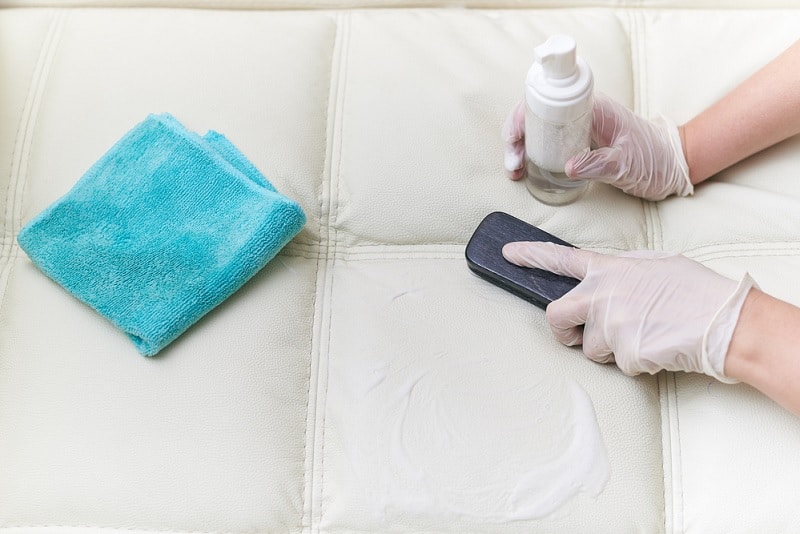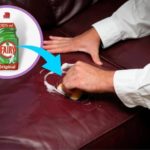A leather sofa is a luxurious and stylish addition to any modern living space. However, a leather couch doesn’t come cheap—it’s also an investment that requires proper care and maintenance to retain its elegance and durability.
Regular cleaning and proper handling can significantly extend the lifespan of your leather sofa, ensuring it remains a centrepiece of your home for years to come. Unlike fabric sofas, leather can be a challenging material to clean without causing damage.
In this guide, we will explore various methods on how to clean a leather sofa, keeping it looking pristine and inviting.
Continue reading for everything you need to know, from the most effective cleaning products for leather to the best cleaning practices.
What’s the Best Way to Clean a Leather Sofa?
Knowing how to care for a leather sofa is essential to maintaining its beauty, and cleaning is a large part of that.
By following the steps outlined in this guide on how to clean a leather sofa, you can ensure that your prized furniture piece remains a focal point in your living space.
So, roll up your sleeves and get ready to give your leather sofa the care it deserves! Here is everything you need to know about cleaning a leather sofa.
Step 1: Prepare the leather surface
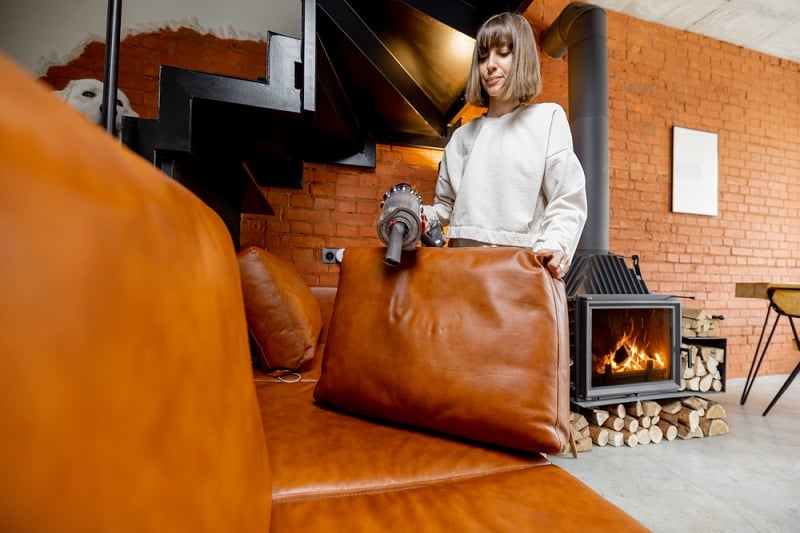
Before cleaning your leather sofa, it’s essential to remove any loose dirt, debris, or crumbs.
You can use a soft brush or vacuum cleaner with a brush attachment to gently sweep the surface, ensuring no abrasive particles will scratch the leather during the cleaning process.
If you have a recliner sofa, check the bottom of the couch. Dust and dirt are susceptible to collecting in the crevice where the base reclines and need to be removed.
Additionally, for sofas with removable cushions, remove these and vacuum both the sofa frame and each cushion individually to remove as must loose dirt as possible.
Step 2: Conduct a spot test
To prevent any potential damage to the leather, always perform a spot test on an inconspicuous area of the sofa before proceeding with the cleaning process.
To do this, apply a small amount of the cleaning solution (see our recommended options below based on the type of leather) and observe any adverse reactions for at least 24 hours.
Do not use the cleaner if there are any signs of discolouration or damage. Instead, conduct a spot test using another cleaner from our list until you find one that doesn’t leave marks behind.
Step 3: Apply cleaner and wipe the sofa
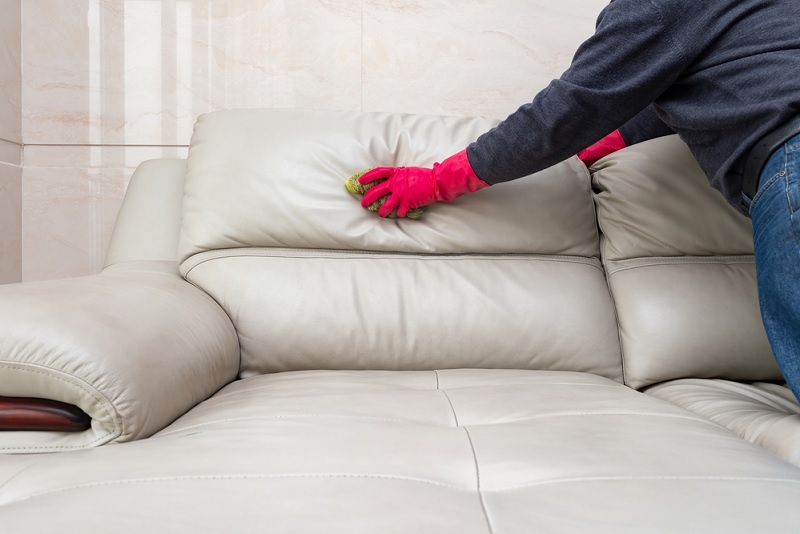
Once you have chosen and tested your leather cleaner, you can start applying it to the couch.
Never apply the product directly onto your furniture, as this can leave behind unwanted spray marks or streaks. You should instead apply it to a clean microfibre cloth and then wipe it on your sofa.
Always begin from the top of your couch, making sure to wipe the cleaner into all areas. This includes all the nooks and crannies, such as between the seat cushions and the crevices between the armrests.
Add more cleaning solution to the cloth as needed, but be careful not to oversaturate your sofa—this can do more harm than good.
Step 4: Remove stains from your leather sofa
If you’re satisfied with the results already, move on to the next step. However, if any stains on your sofa – ink stains, water marks, grease stains, etc. – haven’t been removed, you’ll need to treat these separately.
You will need to apply a stain remover to the unsightly marks to spot-treat them, but the best stain remover for this depends on:
- The type of leather your couch is made of; and
- The type of stain you’re dealing with.
You can find leather-specific stain removers listed further down this article, but your options include bicarbonate of soda and rubbing alcohol.
Meanwhile, grease stains are typically best removed with washing-up liquid, whereas water stains can be removed with – ironically – distilled water.
Always carry out a patch test before treating the stain, and only use stain removers that are safe to use on your specific type of leather (see below).
Step 5: Condition and moisturise the leather
After cleaning, remove any excess cleaning solution using a clean cloth. You can then condition your sofa using a store-bought leather conditioner.
Leather conditioners nourish the material, keeping it soft and supple. This is crucial in restoring the leather’s natural oils and preventing drying or cracking.
Starting at the top of the sofa, apply a high-quality leather conditioner following the manufacturer’s guidelines.
We recommend the Leather Honey Conditioner, whose rich formula leaves your leather feeling and looking beautiful.
Massage the conditioner into the leather in circular motions using a cloth, paying particular attention to areas prone to wear.
After you’ve covered your sofa in conditioner, use a clean cloth to buff the leather gently. This removes any excess conditioner and leaves a beautiful shine.
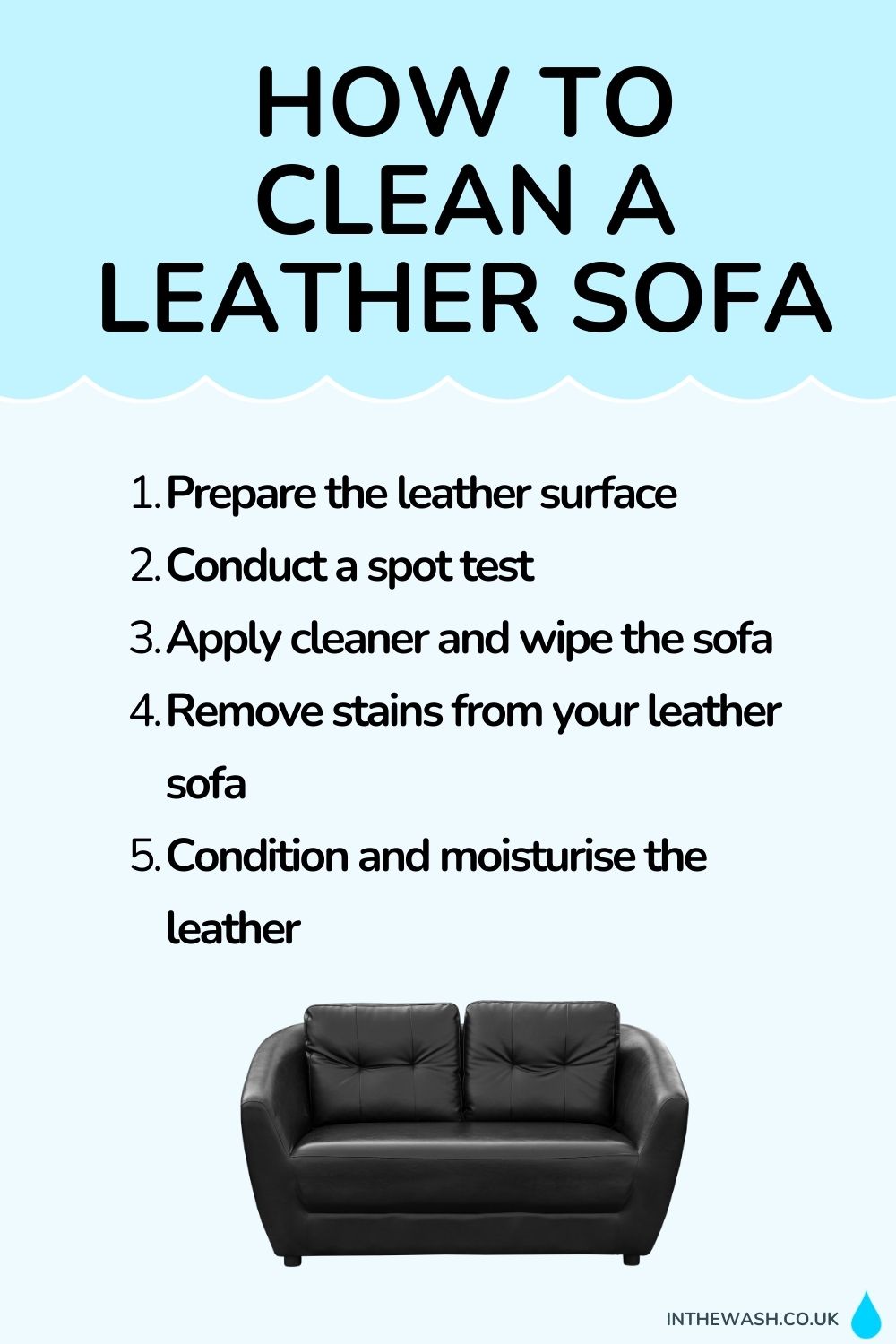
What’s the Best Leather Cleaner for Sofas?
The best cleaner for leather sofas depends on the type of leather used to upholster your furniture. Leather can vary significantly in texture and finish, and each type requires a specific approach when it comes to cleaning.
Identifying which type of leather you’re dealing with therefore makes it easier to clean your couch effectively without damage.
The most common types of leather used in furniture upholstery – along with tips on identifying each type and considerations for cleaning – are as follows. Remember to always do a patch test before applying any of the cleaners to prevent accidental damage.
Cleaning aniline leather sofas
This type of leather is dyed with soluble dyes, offering a natural and soft feel. If you drop water on the material, it will instantly soak into the leather.
Aniline leather is susceptible to stains and fading, requiring gentle cleaning methods. Therefore, we recommend using the following cleaners:
- Distilled water: As the most delicate (and expensive) type of leather, experts often recommend that a couch made from this material is cleaned with nothing but distilled water. This contains no harsh chemicals and won’t cause any damage.
- Mild soap & water: If water isn’t doing the job, try mixing a small amount of mild soap, such as Dove soap or baby shampoo (do not use Fairy Liquid), with warm water. Dampen a soft microfiber cloth with the solution and gently wipe the surface in a circular motion.
- Bicarbonate of soda: For tough stains, make a cleaning paste using bicarbonate of soda and water. Apply the cleaning paste to the stain and let it sit for a few hours before gently wiping it off using a clean cloth.
Cleaning semi-aniline & pigmented leather couches
Semi-aniline leather is similar to aniline leather but with a light protective coating. It strikes a balance between the natural appearance and increased durability.
You can identify this material as a water droplet will sit on the surface before slowly soaking into the couch.
Pigmented leather is similar to semi-aniline leather but has a more durable protective layer, making it more resistant to stains and fading.
It’s easier to clean compared to aniline or semi-aniline leather, and water will sit on the surface and not soak into the material.
Both of these types of leather can handle slightly stronger cleaning products:
- White vinegar & soap: Combine 1 cup of white vinegar, ½ cup of coconut oil, and 1 teaspoon of washing-up liquid in a bowl (more for bigger sofas). Apply the cleaning solution to a soft cloth and wipe over your couch.
- Store-bought leather cleaner: You can alternatively purchase a specialised leather cleaner suitable for semi-aniline or pigmented leather. Follow the manufacturer’s instructions to clean the surface thoroughly, working from top to bottom.
- Rubbing alcohol: Rubbing alcohol penetrates deep into the pores of the leather and is an excellent stain remover. You can apply it directly to the stain or dilute it with water if you’re concerned about damage. It can dry out leather, so ensure you condition your sofa after use.
Cleaning nubuck leather sofas
Sanded or buffed to create a velvety texture, nubuck leather is easiest to identify by touch and sight—its unusual texture is a clear giveaway. This material is the most delicate and requires specialised cleaning techniques.
- Dry cloth: You shouldn’t use any cleaning solution or even water on nubuck leather. Instead, use a soft dry cloth to remove surface dust and dirt. Avoid using water or wet cloths on nubuck sofas, as it can lead to permanent stains.
- Nubuck eraser: To remove light stains or scuffs, gently rub the affected area with a nubuck eraser like this one by Kaps. These are made of a soft yet abrasive material that gently buffs away stains. It works best at eliminating crusty stains from your couch.
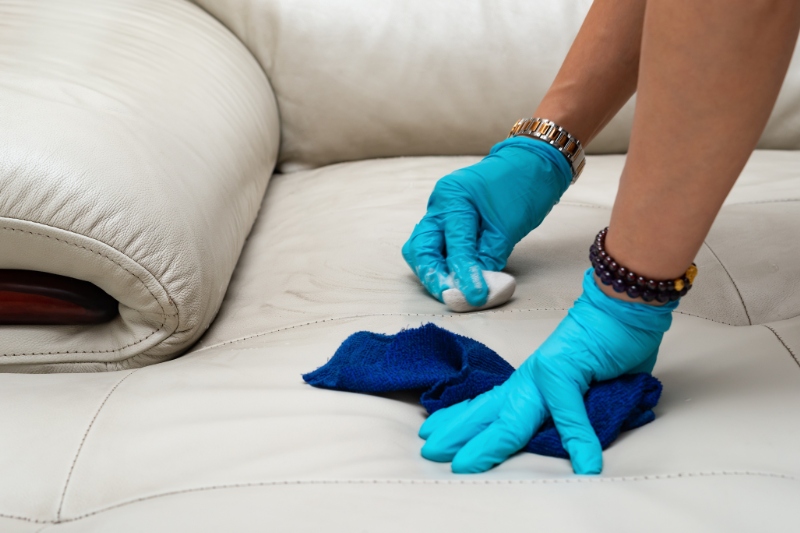
Other Tips for Cleaning a Leather Sofa
- Always treat stains as soon as possible. The quicker you deal with a stain, the less time it has to soak into the couch and the easier it is to remove.
- Water can stain leather, so avoid using too much cleaning solution. Always keep your microfibre cloth damp instead of soaking wet.
- Never spray your cleaning solution directly onto the sofa, which can cause stains. Instead, apply the cleaner to a cloth and use this to wipe your couch.
- Avoid using cleaning products that contain ammonia or bleach. These are too harsh for leather sofas and will cause permanent damage.
- Don’t use wipes to clean up spills quickly. This might seem like a “quick fix,” but it can cause long-term damage to the finish of your sofa.
- Aim to deep clean your sofa (using this guide) twice annually. In between deep cleans, vacuum once per week and treat stains immediately.
Leather Sofa Care Tips
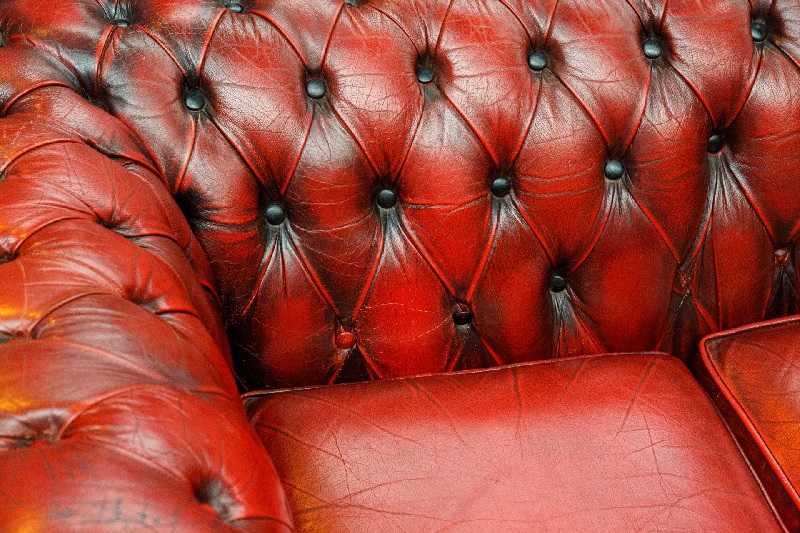
Anyone who is the proud owner of a leather sofa will tell you that maintenance is key to the life and quality of the piece. Whether you’ve just made your first leather investment or you want to show an old piece some love, this article will help you care for a piece old or new.
Dust collectors
It’s common for leather sofas to collect dust, so simply wiping your piece down with a dry cloth will help to keep it looking its best. If there’s still visible build up on your sofa, it’s time to bring out your vacuum cleaner and remove the debris.
Clean and condition
Arguably the most important part, when it comes to the upkeeping of your leather sofa, is the cleaning and conditioning of it. This is what sets caring for leather sofas apart from any other fabric.
Remember: Avoid any cleaning product not specifically designed to treat leather.
Don’t pull threads!
If and when a snag occurs on your leather sofa, you should cut the excess off with a pair of sharp scissors. Under no circumstances should you pull at a tread- no matter how tempting.
Don’t place your sofa against a wall
Although this isn’t strictly to take care of your leather sofa, it’s still important in keeping your home clean! Placing your sofa (especially if forest brown leather) against a wall can mark your walls due to the coating of the leather. Give both your wall and sofa breathing space.
Treat stains immediately
This is just as important with leather goods as it is with any other textile. Stains and spillages should be seen to ASAP with a blotting action. DO NOT rub the spill into the leather as this will lead to a permanent stain. Staying on top of spillages is key to the longevity of your sofa.
If in doubt, speak to a professional
If you’re not sure how to clean your leather sofa effectively (or maybe you just hate cleaning all together) it may be worth hiring a professional cleaner who will be left completely in charge of caring for your beloved sofa.
Don’t sit on the arms
If you’ve ever visited family and been told off for sitting on the arms of their leather sofa (sorry Grandma) there is a good reason for it. Sitting on the arms can cause distortion in the leather.
Keep out of sunlight
Your sofa should be kept out of direct sunlight as it can cause the leather to dry out and crack or even fade in colour. The same goes for heaters or radiators in your home- keep them well away!
It’s commonly perceived that leather goods are hard to care for but, as with any beautiful investment, they just needs love and care every now and again.

Hannah has a passion for cleaning. She worked her way around Australia by cleaning hostels in exchange for free accommodation and used her cleaning skills to bag a job as a chalet host for a luxury ski company in France.
